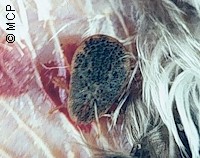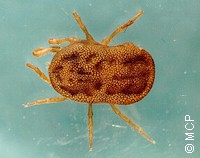Soft ticks are a group of ticks  that belong to the tick family called Argasids.
that belong to the tick family called Argasids.
They are less abundant than hard ticks and are usually not a major issue for livestock, horses or pets, but can be a problem in traditional or outdoor poultry operations in endemic regions. There are about 185 soft tick species worldwide.
The most relevant species for livestock, dogs and cats are the following:
- Argas miniatus, the chicken tick, the South American bird argas; important for poultry; Central America and Caribbean
- Argas persicus, the fowl tick, the poultry tick; important for poultry; worldwide in warm climates
- Argas radiatus, the North American bird argas; North America and Caribbean
- Ornithodorus moubata, the eyeless tampan; the tampan tick; important for poultry; Africa
- Ornithodorus savignyi, the sand tampan; important for livestock, Africa, Asia
- Otobius megnini, the spinous ear tick; important for horses; Americas, Africa, India
All these species attack mainly domestic and wild birds, particularly in warm climates. Argas species do not parasitize mammals. Several species of the genera Ornithodorus (also called Ornithodoros) and Otobius attack wild and domestic mammals, occasionally also cattle, sheep, dogs and cats.
There are specific articles in this site on ticks in dogs and cats, as well as on ticks in horses.
Biology and life cycle of soft ticks

They are called "soft" ticks because they have a "leathery" consistence. Soft ticks are significantly different from hard ticks in their anatomy, but also in their feeding and host-finding behavior.
In contrast with hardticks, the capitulum is below the abdomen and can't be seen from upside, and sof ticks dont' have a dorsal shield (scutum).
Soft ticks behave more like poultry mites than like hard ticks. They build populations close to their hosts, in cracks and crevices of buildings and caves, or in bird nests. They can survive for very long periods without feeding, waiting for their hosts to come back to their nests or shelters. As all ticks, they undergo a metamorphosis and develop through the typical stages of larvae, nymphs (various stages) and adults. The life cycle (i.e. from eggs to eggs of the next generation) can be completed in a few months or many years, depending on species and climatic and ecological conditions, but especially on the presence or absence of suitable hosts. In contrast with hard ticks, mating occurs off the host. Females lay a few hundred eggs in several batches.
The feeding behavior is different from hard ticks. All stages visit the hosts only for feeding, i.e., they change the host repeatedly. Each blood meal lasts between less than an hour and a few days, depending on the species and the stage. All stages drop to the ground for molting. Adult females feed several times between oviposition of egg batches.
Argas ticks parasitize only birds. Adult Argas persicus are 5 to 10 mm long. Larvae feed blood for 2 to 7 days, whereas nymphs and adults only for less than an hour, but repeatedly in about a monthly interval if a host is available. Between the blood meals adult females deposit eggs in cracks and crevices of poultry houses. Adult females can survive more than 4 years without feeding.
Ornithodorus moubata lives in places where animals and humans seek shelter: huts, caves, under trees, etc. During the day they hide in cracks, crevices or under the loose soil. They feed at night when a suitable host is available. They can survive up to 5 and more years without feeding.
Otobius megnini parasitizes dogs, cattle, sheep, horses and many other mammals and birds. Only larvae and nymphs are parasitic. They specifically attach to the ears where they remain for up to 7 months without changing the host. The adults live in cracks and crevices in buildings, between stones, under the bark of trees, etc. They can survive up to two years without feeding.
Click here to learn more about the general biology of ticks.
Harm and economic impact of soft ticks
Soft ticks can be a serious pest in poultry and pig operations in tropical and subtropical countries. Blood loss and subsequent anemia can be significant and substantially affect weight gains and egg laying performance. Massive infestations can cause numerous fatalities.
Argas and Ornithodorus ticks are vectors of numerous poultry diseases such as Borrelia anserina (agent of avian spirochetosis) and Aegyptianella pullorum (agent of aegypitianellosis). Argas ticks also transmit Pasteurella multocida (agent of fowl cholera). Ornithodorus ticks can transmit Borrelia duttoni (agent of African Swine Fever).
In contrast with most other ticks, the bites of Otobius megnini are painful for the hosts. Hundreds of tick larvae and nymphs can congregate in the ears, which are severely affected: irritation, ulceration, clogging, deafness, eardrum perforation and other complications may occur. This is often associated with restlessness, loss of appetite, weight loss, etc. Where it occurs, Ornithodorus savignyi can be a serious pest of cattle. It can cause tick paralysis and can be fatal for calves, and can also cause serious allergies on humans.
Prevention and control of soft ticks
Soft ticks remain most of the time hidden in cracks and crevices in floors and walls in poultry houses, stables, huts, etc. If possible such hiding places should be consequently avoided or eliminated.
Otherwise, high pressure spraying of tickicides is usually the most effective approach to ensure that the tickicides reach the cracks and crevices. Most classic tickicides used for spraying or dipping cattle against hard ticks or poultry against mites will control soft ticks as well. They contain mainly veteran active active ingredients such as organophosphates (e.g. coumaphos, chlorpyrifos), carbamates (e.g. carbaryl) and synthetic pyrethroids (e.g. cypermethrin, deltamethrin, flumethrin) or amitraz. However, being a less common pest, soft ticks are often not included in the label claims of many commercial tickicides.
There is no indication that the Boophilus tick vaccine for cattle may work against soft ticks, neither on cattle nor on any other domestic animal.
So far no biological control methods are available against soft ticks. Learn more about biological control of ticks and mites.
There are no repellents, chemical or natural, that effectively prevent soft ticks from attaching to livestock, or that cause already attached ticks to detach.
There are no traps that effectively reduce soft tick populations: whatever domestic or wild animals are much more attractive for soft ticks than any possible trap.
Neither macrocyclic lactones (e.g. doramectin, eprinomectin, ivermectin, moxidectin), nor tick development inhibitors (fluazuron) ensure adequate control of soft ticks on whatever domestic mammals or birds. This means that there are no systemic tickicides suited for controlling soft ticks, and consequently neither injectables, nor drenches nor feed additives.
Resistance of soft ticks to parasiticides
So far there are no reports on significant problems with soft ticks populations resistant to tickicides. This means that if a particular product has not achieved the expected control, it is most likely because the product is not adequate or it was not used correctly, not because soft ticks have become resistant.
Learn more about parasite resistance and how it develops.
| If available, follow more specific national or regional recommendations or regulations for soft tick control. |